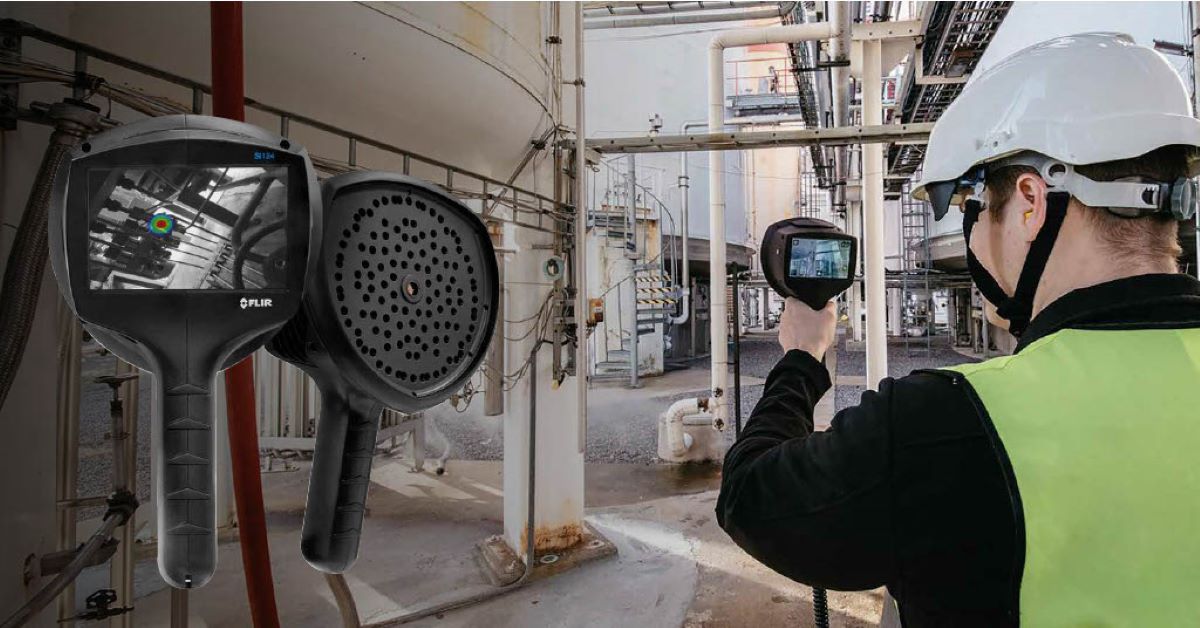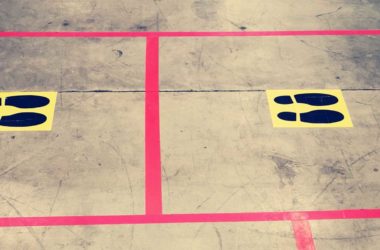Leakages in equipment or pipelines in industrial environments can have a devastating impact on the environment, safety and a company’s productivity – and subsequently its bottom line. Therefore, investing in leak detection equipment, like an acoustic imaging camera, is a sure-fire way to negate these issues, ensuring the safety of the workforce and reducing costs in energy loss.
Leak detection equipment is set to become more in-demand over the next few years, with Grand View Research claiming that the Leak Detection and Repair (LDAR) market was valued at $19.71 billion in 2022, and is expected to grow at a compound annual growth rate (CAGR) of 4.5% to 2030. This indicates that leak detection equipment is to be considered a necessity on the workbench, and as more sophisticated tools are developed and become available on the market, demand is only going to rise.
The Importance of Leak Detection
From ensuring the safety of workers and the surrounding community to safeguarding the environment and maintaining operational efficiency, the significance of leak detection cannot be overstated. Some of the major reasons for adding leak detection equipment to your workbench are listed below:
- Safety – Hazardous substances, gases, and chemicals are frequently handled in industrial operations. Leaks can result in toxic exposure, fires, explosions, and other circumstances that put the lives of workers, nearby communities, and the environment in danger.
- Environment protection – Leaks can cause environmental pollution and long-term harm to ecosystems by releasing toxic compounds and pollutants into the air, water, and soil. Such emissions and the related ecological effects can be avoided with effective leak detection.
- Reduce costs – Quick leak detection and repair can reduce the loss of valuable resources including raw materials, energy, and water and also limit any damage to other pieces of equipment. Over time, this will result in considerable cost reductions.
- Operational efficiency – Leaks often signify inefficiencies in industrial processes. These inefficiencies can lead to product loss, increased operational costs, and decreased production quality.
- Regulatory compliance – Strict laws governing emissions, pollution, and safety apply to many businesses. Leaks that are not found and fixed may result in penalties, legal actions, and reputational harm.
- Equipment health – Leaks can occasionally be a sign of equipment integrity or wear and tear issues. Early leak detection can reduce the likelihood of equipment failure and the need for pricey repairs or replacements.
Air Leaks with an Acoustic Imaging Camera
There are a range of different types of leaks in industrial settings such as gas, water and air. In this article, we will discuss how acoustic imaging cameras are used to detect air leaks in factories.
Pressurised air systems are one of the largest electricity costs in most factories, so detecting any leakages or equipment failures early is incredibly important to avoid any unexpected problems. Traditional methods like soap bubble testing can take significant time, whereas an acoustic imaging camera gives results in real time. Find out more about acoustic imaging cameras and the FLIR Si124 below.
What is an Acoustic Imaging Camera?
An acoustic imaging camera, or acoustic camera, is a handheld device used to identify a variety of types of leaks in industrial equipment, pipelines and other systems. The majority of leaks cause turbulence, which then generates ultrasonic noise. An acoustic imaging camera, like the FLIR Si124, locates the noise’s source and in real time overlays that “hotspot” onto a visual camera image. Acoustic imaging cameras are a valuable asset to any workbench, helping to improve safety, reduce costs and give real-time data.
How does an Acoustic Imaging Camera Work?
Sound capture
Acoustic cameras consist of a microphone array, a sound processing section and a display screen. There are hundreds or even thousands of tiny microphones in a microphone array, meaning it can pick up the quietest of noises and from a range of directions and angles. As sound waves propagate through the air, they reach each microphone at slightly different times due to their varying distances from the source. The time differences in arrival at each microphone are used to calculate the direction from which the sound originated. This is called time difference of arrival (TDOA).
Data processing
Advanced algorithms that examine the timing and strength of the signals acquired by the microphones are used to process the captured sound signals. These algorithms determine the sound sources’ spatial coordinates. A visual representation of the sound sources is created using the processed data, and displayed on the camera screen. This may take the shape of an image or heatmap, with each point on the image denoting a different sound source, and the colour or size of the point denoting the volume or intensity of the sound. What’s unique about the Si124 is that leak quantification and cost analysis is made simple, so operators don’t need any training in acoustics, eliminating the need for complicated tables and algorithms too.
The Si124 is a smart tool that offers leak-size and leak-cost analysis using on-device analytics. This enables a facility to calculate the projected annual energy expense brought on by compressed air or vacuum leakage with ease. The device immediately uploads images it has just taken via Wi-Fi to the FLIR Acoustic Camera Viewer cloud service. Then users may easily conduct deep analysis using stored photos, generate reports for air leak audits, or utilise FLIR Thermal Studio software to construct sophisticated studies or combine thermal imaging and sound imaging in one report.
Image analysis
Operators use the visual image to pinpoint and identify particular sound sources. They can ascertain the type and importance of the sound-producing components by examining the intensity and dispersion of points. Operators can then take the necessary action once the sources of interest have been located. This could include taking care of leaks, carrying out maintenance, modifying machine settings, or putting in place noise reduction techniques. The time required for ultrasound inspection can be reduced by around 90% by imaging the noise source.
Six Things to Consider when Buying an Acoustic Imaging Camera
FLIR is one of the market leaders in acoustic imaging camera technology. To help you make the right decision when choosing the correct piece of equipment, the American company has outlined six things to watch out for before purchasing below:
Effective frequency range
Having a wide frequency range doesn’t necessarily mean your acoustic imaging camera will detect more sounds. The effective frequency range for distinguishing compressed air leaks from background factory noise is between 20 and 30 kHz, while the optimal range for detecting partial discharge from a safe distance is 10 to 30 kHz.
Optimal number of microphones
In the pursuit of quieter noises, more is better. This is because a single microphone, while capable of picking up sound (signal), also creates a small amount of sound itself (noise). Adding more microphones improves the signal-to-noise ratio, allowing an acoustic imaging camera to pick up more sound without noise interference.
Sound detection range
Adding just the right number of microphones to an acoustic imaging camera can also improve the chances of picking up very quiet noises from a long distance. For example, quadrupling the number of microphones can double the sound detection range.
Microphone placement
The placement of microphones helps an acoustic camera determine the direction and location of sounds. Microphones need to be grouped closely together to ensure they collect enough data to correctly determine from what direction they originated.
Microphone performance
Adding too many microphones has diminishing returns: you either need to add a lot of processing power or reduce the sound resolution to accommodate the number of mics. With 124 microphones and advanced processing power, the FLIR Si124 provides industry-leading detection sensitivity, excellent acoustic image resolution and a great range.
Intelligent analytics
The final features to consider are the computing power and analytics. Look for an acoustic imaging camera like the FLIR Si124, which offers on-camera analytics, automatic image upload when connected to your Wi-Fi, easy-to-understand reporting, and predictive analysis using an AI/web tool.
FLIR Si124 Acoustic Imaging Camera
Reduce inspection time by up to 90%
The FLIR Si124 acoustic imaging camera, an advanced ultrasonic solution for air leak detection, finds even minor leaks effortlessly and from a distance, making inspections safer to conduct. The lightweight, portable device is easy to use with only one hand and provides real-time leak size and cost estimates using AI-driven analytics, which make determining the urgency of repair actions easy.
Equipped with 124 microphones, the Si124 enables exceptional sensitivity and accuracy in finding even small leaks in noisy industrial settings, such as tyre manufacturing plants. Operators can locate pressurised leaks in compressed air systems up to 10 times faster than point scanning methods.
Industrial manufacturing facilities have various levels of background noise, making it extremely difficult to hear an air leak with human ears alone. In general, background noise interferes less at high frequencies, and air leaks are best detected at long distances with frequencies between 20 and 30 kHz. The FLIR Si124 frequency range of 2 to 31 kHz is optimised to detect the smallest leaks at the longest distances or to detect even smaller leaks at close distances using frequencies up to 65 kHz.
Finding the optimal frequency in a noisy environment. Source: FLIR
Applications
- Food and beverage industry – Built with 124 microphones, the FLIR Si124 can detect and pinpoint minute leaks at long distances. This includes areas with noisy machinery – making it ideal for large food and beverage manufacturing plants.
- Automotive industry – Automotive manufacturing and diagnostics involve many processes that use pneumatic systems with compressed air. This includes metal casting, metal working, tool making, CNC machines, assembly lines, sandblasting and car paint booths. Common weak points in the equipment include valves, pipes, hoses, connectors and tools.
- Pulp and paper industry – In contrast to traditional methods like sniffers and leak sprays, the FLIR Si124 ultrasonic air leak detector offers a much safer and faster alternative for maintenance personnel. Its advanced technology enables compressed air leaks to be identified accurately and quickly from a distance.
FLIR Si124 features
- Auto Filter selects the best frequency range automatically to detect even the smallest leaks.
- Quickly locate leaks and automatically upload, analyse, and classify problems to improve the reliability in production lines.
- Locate leaks precisely, even in loud industrial environments, thanks to high-resolution acoustic images and 124 built-in microphones.
- Instantly view the leak rate onscreen in real time (l/min or CFM).
- Delay the expense of installing new or additional compressors by maintaining existing ones.
- Reduce rejected products that could be caused by pressure loss in pneumatic systems.
- Quantify leak size to understand how much energy was lost and the amount of money saved by discovering the problem.
- Optimise staff time, as minimal training is required to use Si124-LD Plus.
- Upload, store, and backup data; create reports; and conduct deep analysis using FLIR Acoustic Camera Viewer cloud software or FLIR Thermal Studio suite desktop software.
- Operate the lightweight camera with one hand for safety and reduced strain.
- Easily review images on the display in bright or dark conditions with this adaptable gain camera.
Return on investment
The FLIR website also allows you to calculate the return on investment of the Si124 acoustic imaging camera. This means you can easily see its potential impact on your bottom line. Try it out here, and take a look at an example breakdown below.












